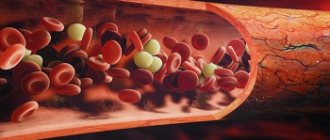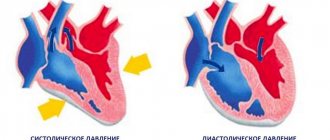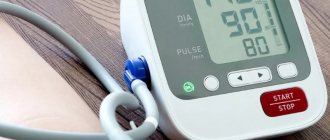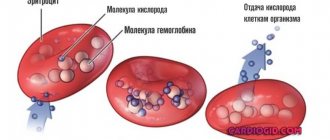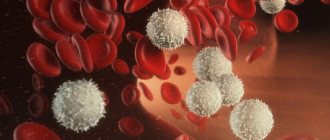RDW in a blood test: increased and decreased, methods of normalization
RDW (Red cell Distribution Width) or Red cell distribution width is an indicator of the range of changes in red blood cells (erythrocytes) in their sizes. In short, RWD is a measure of how equal in size the red blood cells are in the blood. This indicator may indicate various diseases and disorders in the body. Such diseases include autoimmune and inflammatory problems, liver, kidney and cardiovascular diseases. Below in the article we will explain why increased RDW is bad and how this indicator can be normalized.
The article is based on the findings of 78 scientific studies
The article quotes the authors:
- University of Mississippi, USA
- University of Hawaii, John A. Burns School of Medicine, USA
- Department of Obstetrics and Gynecology, Manisa Merkezefendi Hospital and Manisa Akhisar Public Hospital, Turkey
- Department of Laboratory Medicine, Military Command Area General Hospital, China
- Diparnto di Scienze Morfologico-Biomediche, Sezione di Chimica Clinica, Italy
- and other authors.
Please note that the numbers in parentheses (1, 2, 3, etc.) are clickable links to peer-reviewed scientific studies. You can follow these links and read the original source of information for the article.
Red blood cells, also called erythrocytes, are the cellular component of blood.
Millions of these cells move through the blood vessels and give the blood its characteristic color, carrying oxygen from the lungs to the body's tissues and carbon dioxide, a waste product, back to the lungs for removal from the body. Typically, red blood cells have a standard size of about 6-8 microns in diameter. They are round, biconvex cells that look like dumbbells in profile. These cells are very flexible and take on a bell shape as they pass through very small blood vessels called capillaries. [R] Red blood cells are covered by a membrane made of lipids and proteins, they do not have a nucleus, and they contain hemoglobin (a red, iron-rich protein that binds oxygen).
BLOOD CELLS: platelets, erythrocytes and white blood cells (basophils, neutrophils, eosinophils, monocytes, lymphocytes).
Why is it necessary to do an RDW analysis?
It was already mentioned above that the index of distribution of red blood cells in the blood makes it possible to conduct a qualitative assessment of the composition of red blood cells, taking into account their size.
But why is this necessary? The thing is that these cells are very similar to each other, which gives them the opportunity to replace each other or form blastulas. An increase in cell size entails an increased need for nutrition and, in addition, this means that their life expectancy is reduced. All this directly affects the overall indicator of red blood cells in the blood and the human condition.
When a large number of red blood cells die, iron is released and more bilirubin becomes available, which puts increased stress on the liver, and as a result, it cannot process these substances.
The RDW index is directly related to the pathological process, during which the dimensions of erythrocytes change (anisocytosis). This condition is a complex chemical process that causes all blood cells to suffer.
What is RDW
Red blood cell distribution width (RDW) is the change in size (volume) of red blood cells (RBCs). Basically, this test tells you how equal or unequal your red blood cells are in size. The RDW is part of a complete blood count that also measures hemoglobin, hematocrit, and red and white blood cell counts. [r, r]
LEFT - ALMOST THE SAME SIZES OF RED CELLS (RDW - NORMAL), RIGHT - SIZES OF RED CELLS VARY GREATLY (RDW - NOT NORMAL)
Low RDW values mean your red blood cells are about the same size, which is normal and desirable. But higher RDW values mean that your red blood cells are produced in different sizes. In other words, there are some problems with the production and survival of red blood cells. [r, r, r]
The RDW value is an important, but not specific (not indicating a specific disease) value, therefore the width of the distribution of erythrocytes by volume is used in combination, along with other blood indicators.
Therefore, along with RDW, blood tests also measure such indicators as: MCV (average erythrocyte volume), MCHC (average hemoglobin concentration in an erythrocyte).
How is it determined
The red blood cell distribution index RDW SD is calculated using a mathematical equation. The result is a percentage ratio of the number of bodies and their mass. The result of the analysis looks like a histogram with a curve, which indicates changes in the parameters of red blood cells. Venous blood is taken for analysis. The biological material is collected in a test tube and placed in a centrifuge, in which the blood cells are separated from the liquid.
To count red blood cells and determine their parameters, the sample is placed in a special analyzer, which independently analyzes the cells.
RDW increased: association with diseases
Elevated RDW values may indicate, but do not diagnose or confirm, the following diseases: [p, p, p, p]
- Lack of iron in the body or vitamin deficiency
- Lack of B vitamins, including B12 and folic acid
- Anemia (various types, including sickle cell anemia)
- Inflammation
- Insomnia
- Cardiovascular diseases
- Blood loss due to hemorrhage (including surgery)
- Thalassemia
- Liver disease
- Kidney disease
- Cancer
- Alzheimer's disease
- Alcoholism
- and others.
However, RDW may still be at normal levels in people with leukemia, or with certain types of anemia (such as aplastic anemia). Therefore, it is important to look not only at the RDW value, but also at the relationship with other markers. [R]
What measures to take?
What to do when the red blood cell distribution index is low?
A highly qualified doctor during a consultation will most likely ask the patient to take the test again, because the RDW indicator is almost never underestimated. Because this suggests that all cells are ideal in their parameters, but this cannot happen in principle. If the indicator is confirmed by repeated analysis, then a full examination of the body’s condition is carried out, paying special attention to oncological examinations.
Normal RDW values
Normal RDW values are the same for men and women. The range of normal RDW in adults is 11.5 - 15.5%, but may vary slightly depending on the reagents used by different laboratories.
In newborn children, normal RDW values are increased to 14.9 - 18.7% due to stress at birth and adjustment to life outside the mother. But as children grow older, their normal RDW values gradually approach those of adults.
At the same time, with age, red blood cells become more varied in size (volume), which leads to an increase in RDW. [R]
Treatment process
During the treatment process, it is important to exclude the influence of the etiological factor that provoked the onset of the disease. If hypoxia is detected in the patient, oxygen treatment is necessary. If the level of red blood cells in the bone marrow has increased, it is necessary to treat with a blood replacement solution and glucose. In case of advanced disease, the patient must be prescribed medications that thin the blood. This will help prevent the formation of blood clots. During the treatment process, it is important to follow the diet prescribed by the attending physician. Physicians often prescribe bloodletting - this will help reduce hemoglobin levels. When using oxygen inhalation, the functioning of oxygen transport into human cells is restored. Specific medications are prescribed by the doctor depending on the identified disease and the general health of the patient.
RDW reduced
A low RDW value indicates that your red blood cells are uniform in size, which is desirable for health. [R] However, it is worth remembering that there is still a possibility of having some kind of disease. [R]
For example, with reduced RDW values, one may suspect disturbances in the functioning of the spleen, where damaged red blood cells are recycled. In addition, if RDW is low, it is worth thinking about the following possible reasons:
- Recent surgery
- Blood donation
- Severe blood loss (including hidden in the stomach and intestines)
- Hormonal disorders during pregnancy, puberty, and when taking contraceptives
How to lower the level of RDV
To find out how to normalize this blood count, the specialist must refer the patient for additional examinations.
In any case, therapy should be carried out with an integrated approach, which consists of the use of certain medications and physiotherapeutic procedures.
Sometimes, if necessary, surgery may be prescribed
.
Thus, RDW is an important indicator that helps diagnose various pathological processes in the body. In addition, it allows you to determine the type of anemia.
RDW increased
A high RDW means your red blood cells (RBCs) are unequal in size. This condition is called anisocytosis. [r, r] This happens when, for some reason, you have trouble producing red blood cells.
Anisocytosis is determined by RDW and is classified according to red blood cell size along with MCV (mean erythrocyte volume):
- Anisocytosis with microcytosis (small red blood cells). Possible causes: iron deficiency, sickle cell anemia.
- Anisocytosis with macrocytosis (large red blood cells). Possible causes: deficiency of vitamin B12 or folic acid, autoimmune hemolytic anemia, cytotoxic chemotherapy, chronic liver disease, myelodysplastic syndrome.
- Anisocytosis with normal erythrocyte sizes. Possible causes: iron deficiency, vitamin B12 or folic acid deficiency, dimorphic anemia, sickle cell anemia, chronic liver disease, myelodysplastic syndrome.
ABNORMAL SHAPE AND SIZE OF RED CYTES
Reduced RDW: norm and pathology
A person in good health has red blood cells of the same shape, density and color. In case of deviation, especially in the presence of autoimmune diseases or oncology, the failure occurs at the level of microcells, when young cells do not receive a certain number of components, which, in fact, inhibits their performance. Thus, anemia occurs - a pathology during which the body does not receive the required amount of oxygen, in other words, the metabolic function in red blood cells is disrupted.
Reasons for increasing RDW
Nutrient deficiency
Deficiencies of various nutrients can cause an increase in RDW, for example:
- Iron deficiency [r, r, r, r]
- Folic acid deficiency [R]
- Vitamin B12 deficiency [r, r]
This is because your body needs these nutrients to produce healthy red blood cells. Any of these deficiencies can eventually lead to anemia.
Inflammation
Some studies suggest that higher RDW values are associated with inflammation and higher levels of inflammatory cytokines such as IL-6, IL-8 and TNF-alpha. [r, r, r, r, r, r, r]
Inflammatory cytokines can interfere with red blood cell production and thereby increase RDW. Additionally, oxidative stress, which often accompanies chronic inflammation, can reduce red blood cell lifespan and further increase RDW values. [R, R]
High RDW has been found in people with diseases associated with inflammation, such as inflammatory bowel disease, celiac disease, polycystic ovary syndrome (PCOS), and major depressive disorder (MDD). [r, r, r, r]
REASONS FOR INCREASING RDW
Sleep disorders
In a study of 17,500 adults, those who slept less or more than 7-8 hours a night were more likely to have high RDW values. This was especially true for people who slept 10 hours a night - their chances of having increased RDW increased by almost 70%. [R]
RDW values are higher in people with sleep apnea. [r, r]
RDW scores were also associated with shift work with circadian rhythm disruption. In a study of 7,000 women, those who worked shift shifts were almost 50% more likely to experience an increase in RDW compared to women who worked day shifts. [R]
Bleeding
Severe and moderate injuries with heavy bleeding increase RDW. [R] Bleeding may not be visible, as is the case with intestinal and gastric bleeding. [r, r]
Blood transfusion
If a person undergoes multiple blood transfusions, their RDW may increase due to differences in blood composition between the donor and recipient. [r, r]
Liver disease
Increases in RDW occur in a variety of liver diseases, including hepatitis, alcoholic cirrhosis, biliary cirrhosis, and liver cancer. [R]
An observational study of 423 adults with liver disease found that their RDW was significantly higher than that of healthy controls. [R]
In another study of 446 hepatitis B patients, increasing RDW levels corresponded with increased liver size (hepatomegaly) and increased inflammation. [R]
Kidney disease
One of the kidney hormones, erythropoietin, is needed for the maturation of blood cells. Problems with the production of this hormone occur with kidney disease, leading to the development of RDW. [R] People with reduced kidney function have higher RDW levels. [R]
Alcoholism
Alcoholics can exhibit high RDW values without liver disease. This is because alcohol can have a toxic effect on red blood cells. [R]
Thalassemia
Thalassemia may cause increased RDW values. However, patients with thalassemia may also demonstrate normal RDW levels. [r, r, r]
Sickle cell anemia and hereditary spherocytosis
Sickle cell anemia is an inherited disease. People with this disease have higher RDW values because many of their red blood cells are misshapen. [R]
Hereditary spherocytosis (Minkowski-Choffard disease), another disease in which red blood cells become misshapen, also causes increased RDW levels. [r, r]
DISEASES IN WHICH RDW LEVELS INCREASE (https://medcraveonline.com)
Cancer
RDW rates are often higher in a variety of cancers, including stomach cancer, liver cancer, colon cancer, and kidney cancer. [r, r, r, r]
There are many factors in cancer that can interfere with the normal production of blood cells, including chronic inflammation and poor nutrition.
In cancer, RDW often increases with disease severity and metastasis. [R]
In a study of 25,000 people, the risk of cancer was 30% higher in those people who showed the highest RDW values compared to people with the lowest values. Postmenopausal women with the highest RDW values had a 22% increased risk of developing cancer. But no association was found between RDW values and cancer in premenopausal women. [R]
Cardiovascular diseases
According to a meta-analysis, an increase in RDW levels accompanies various cardiovascular diseases: acute coronary syndrome (including myocardial infarction), coronary heart disease, peripheral arterial disease, arterial hypertension, and also with atrial fibrillation. Higher RDW values predict more negative outcomes for these diseases.
Increased RDW has been associated with various types of cardiovascular disease in studies. [r, r, r]
In a study of 25,500 adults, each 1% increase in RDW resulted in a 13% increase in heart attack risk. Those people who showed low RDW values had a 71% reduced risk of having a heart attack (myocardial infarction) compared to people with the highest RDW levels. [R]
Elevated levels of RDW are associated with a high risk of cholesterol plaque building up in the arteries (atherosclerosis) in patients with hypertension. [R]
RWD is associated with autoimmune diseases
There is an association between high RDW levels and increased disease activity in autoimmune problems such as rheumatoid arthritis, lupus, psoriasis, Crohn's disease, Sjögren's syndrome, systemic scleroderma, and ankylosing spondylitis (ankylosing spondylitis). [r, r, r, r, r, r, r]
INCREASING RDW WITH INCREASING CROHN'S DISEASE/ULCERATIVE COLITIS ACTIVITY (https://www.wjgnet.com)
RWD and metabolic syndrome
People with higher levels of RDW show more advanced degrees of metabolic syndrome. This was found in studies involving more than 217,000 people. [r, r]
RWD and diabetes risk
In a study that monitored more than 2,600 people with normal blood glucose levels over 4 years, high RDW values increased the risk of developing diabetes by nearly 2 times compared to people with low RDW. [R]
RWD and risk of dementia (dementia)
In a study of approximately 2,500 older adults, higher RDW values had an increased risk of dementia. This risk was significant in those people who were not anemic. [R]
RWD is associated with mortality
High RDW values increase inflammation and oxidative stress, which contribute to the risk of mortality. In various studies, adult (45+) hospital patients with elevated RDW levels demonstrated a higher risk of cardiovascular mortality, infection, and all-cause mortality. [r, r, r]
Additionally, in a review of 13 studies (involving 10,410 patients), low RDW was associated with a lower risk of mortality. [R]
RDW and depression
The study, which followed 43,226 patients with depression for 5.3 years, measured RDW values at the time of diagnosis and in subsequent contacts with doctors. It was found that patients with cardiovascular diseases with increasing RDW had more advanced depressive syndromes.
Degrees of anisocytosis
Erythrocyte anisocytosis is divided into four stages:
- I degree. Diagnosed when 27% or 50% of red blood cells have a different volume.
- II degree. Occurs when 55% or 70% of red blood cells have a change in size.
- III degree. More than 75% of blood cells are modified and have different dimensions.
- IV degree. Almost 100% of blood cells are different from normal.
Clinical analysis reveals blood levels of rdw, ranging from a slight degree to a pronounced degree, when the highest percentage of deviation from the blood flow composition standards is detected. In ideal condition, the size of red blood cells should vary between 7-9 micrometers. According to the degree of change in the size of red blood cells in one direction or another, anisocytosis is classified into:
- Macroanacitosis - a larger number of red blood cells of increased volume.
- Microanacitosis is the predominant number of red blood cells of small diameter.
- Mixed type, combining macrocytes and microcytes.
There are also megalocytes, which have the maximum possible blood cell size of more than 12 microns. Macrocytes are red blood cells whose size is more than 8 microns. Their normal amount should be in the range of 12−15%. Microcytes include blood cells smaller than 6.9 microns. Mixed anisocytosis is characterized by the presence of both reduced and enlarged blood cells in the bloodstream. Combined studies are carried out using the calculation method using the Price-Jones curve.
Ways to reduce RWD
First of all, it is necessary to treat the underlying disease - the cause of increased RDW values. Below are additional options that can help you improve your health and reduce your RDW.
Balanced diet
Eating a healthy and balanced diet helps prevent nutritional deficiencies. It is especially important that the diet contains the recommended amounts of iron, folic acid and vitamin B12. [R, R, R] Correcting nutritional deficiencies can improve blood cell production and lower RDW values.
Reduce alcohol consumption
Reducing alcohol consumption may help reduce damage to red blood cells. [R,R] In addition, alcohol also reduces the absorption of nutrients such as vitamin B12 and folic acid, which are essential for the production of red blood cells. [r, r]
More physical activity
People who do little or no physical activity show higher levels of RDW. [r, r]
Exercise, including light intensity exercise, has been shown in research to improve RDW scores. [r, r, r]
In a study of more than 8,000 people, as the amount of exercise time per week increased, the risk of showing increased levels of RDW decreased by 11%. [R]
Quit smoking
Smoking increases oxidative stress. Higher RDWs are identified in smokers and are associated with the number of cigarettes smoked per day as well as the duration of smoking. [R]
Preventive measures
You can prevent a reduced RDW by following these simple rules:
- The diet should be balanced, which includes plenty of fresh fruits, lean meats and vegetables.
- It is recommended to breathe fresh air as often as possible.
- An active lifestyle will help prevent a decrease in the RDW index.
- It is very important not to skip routine medical examinations, during which most often serious deviations from the norm are detected that do not have external symptoms.
As a result, we learned that the red blood cell distribution index reflects their dimensions relative to each other and makes it possible to learn about their biological value. A decrease in RDW is very rare, but if the erythrocyte distribution index is decreased, this means that various pathologies may be present.
The index is calculated based on the results of a general blood test, but can only be fully valid in conjunction with the MCV indicator, since they are closely interrelated.
Preparing for the study
To obtain a reliable and accurate result, it is important to follow the recommended rules for preparing for analysis. Therefore, experts advise adhering to the following recommendations:
You should donate blood on an empty stomach. The interval between food intake and collection of biomaterial should be at least eight hours
Therefore, doctors advise taking it in the morning. Before the analysis, avoid drinking alcoholic beverages the day before. It is recommended not to smoke a few hours before the diagnosis. An hour before the manipulation, it is important to eliminate physical and emotional stress. Immediately before the procedure, you need to sit quietly for at least 15 minutes. If a person took medications the day before, it is important to inform the laboratory assistant about this. After some diagnostic procedures, for example, after a rectal examination, it is advisable to donate blood after a certain time.
Some clinics recommend bringing disposable sterile gloves and a scarifier with you. They can be purchased at any pharmacy.
Increased coefficient value
Most often, patients have an increased value of the width of the distribution of red cells in volume. This symptom is not a separate disease, but is a sign of a pathological course.
With this process, the spleen enlarges, which causes a disruption in the functioning of other organs.
The main reasons for increasing RDW:
- liver pathologies;
- deficiency of vitamins A, B12;
- lack of folic acid, iron;
- malignant neoplasms;
- excessive alcohol consumption;
- leukocytosis.
An increase in the indicator also occurs with intoxication with chemical elements and cardiovascular diseases. With this pathology, the patient experiences yellowing of the skin due to impaired functioning of the spleen and liver. A person gets tired quickly, sweating increases. Due to a malfunction of the nervous system, the patient's mood often changes.
To get rid of the symptoms, you need to install the disease key. In addition to medication treatment, it is necessary to adjust your lifestyle and diet. If you follow all the doctor’s recommendations, you can bring the red blood cell count and their functioning back to normal. You should take a course of vitamins and monitor your hemoglobin levels.
When the root of the disease is severe pathologies, the medical professional will prescribe additional diagnostics and individual treatment. Only a doctor can determine the required dosage and the appropriate course of therapy. In this case, you should regularly donate blood to monitor the effectiveness of medication treatment.


